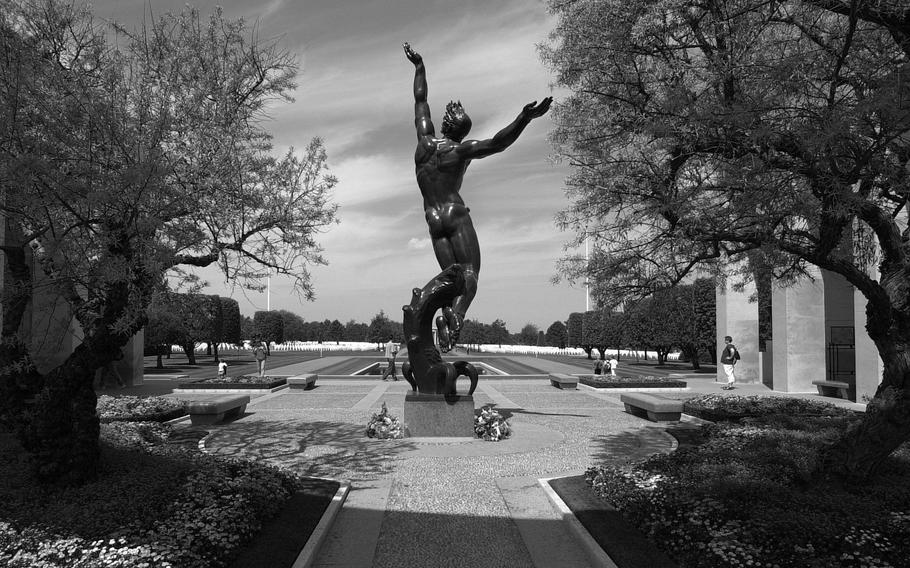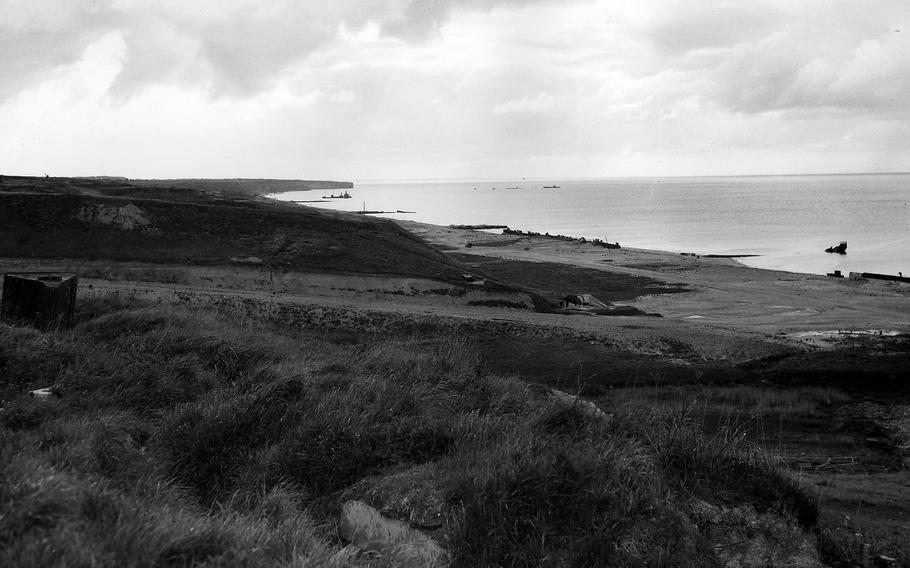
The statue “Spirit of American Youth” rises up from the memorial at Normandy American Cemetery, above the D-Day landing sites at Omaha Beach. (Michael Abrams/Stars and Stripes)
This month of the 80th Anniversary of D-Day, Stars and Stripes is republishing a number of articles as reported by its staff writers at the time. This article — describing the first wave of 1st Infantry Division troops landing on Omaha Beach — first appeared in the Stars and Stripes London edition June 9, 1944. It is republished unedited in its original form.
ABOARD THE USS HENRICO OFF THE FRENCH COAST, June 6 (delayed) — Sheer guts won a foothold on the beach we are attacking. Salt-stained small boatmen, returning from the first wave, are almost reverent in their praise of American Infantrymen who charged the beaches.
Each coxswain and gunner tells the same story. The first crest rode in on a choppy sea without a shot being fired at them. On our beach most of the LCVPs and LCMs grounded on a sandbar a few feet from shore. GIs removed their rifles from waterproof containers and prepared to wade through hip-deep surf.
Then, as the boat ramp went down, the Yanks charged. They were met by streams of .50-cal. machine-gun bullets. German gunners were firing in precise patterns from concealed pillboxes.
Coxswain Richard Andrews, 18, of Hughesville, Pa., was at the tiller of the first LCVP to get back from the initial assault. “Everything was quiet as we approached the shore,” he said. “Most of the soldiers thought the beach would be a pushover. We were exactly on time. Smoke from the naval barrage was still coming up from burning spots inland. My gunners cranked down the ramp. The infantry officer drew his pistol and waved his men after him. As the first group of men left the boat the machine-guns opened up. They mowed the troops down. Still the men in the boat pressed forward, some of them shooting toward the pillboxes. They plunged into the surf, but the fire dropped them into the water.

Omaha Beach, shown here in May 1946, was the site of some of the bloodiest fighting of the D-Day invasion. U.S. troops suffered around 2,000 dead, wounded and missing there. (Stars and Stripes)
One of the Navy boatmen loudest in his praise of the infantrymen was Jerry Dever, S/1c, of Tacoma, Wash. He was a gunner aboard an LCM which hit the beach with 96 soldiers.
“None of them faltered,” he said. “They followed their officers, shooting as they went. But the fire was too much for them. I saw only one man reach the shore.”
The rest of Dever’s story was supplied by Ensign J.L. Sunde, of Moorhead, Minn., in command of the boat. “Dever went wild when he saw the soldiers go down,” he said. “Before I could stop him he leaped into the surf and grabbed a floating, wounded man. He threw him back into the boat and went for another and another. He pulled seven of them into the craft before the fire forced us to shove off.”
One group of GIs got ashore because Devon Swift, of Fort Wayne, Ind., a seaman at the tiller of an LCVP, took a chance and brough this boat in between two tanks at the water’s edge. “I didn’t know whether they were German or American,” he said, “But they were so close that I could look down the gun muzzles. I figured they would have fired already if they were Germans and beached the boat right between them. The troops took positions behind cover of the tanks and started shooting at the pill boxes.”
Swift had two crewmen with him, Ralph Buffone, machinist’s mate third class, of Waterloo, N.Y., and Joseph Burda, SM/3c of Jewett City, Conn.
Tonight the weary boatmen have secured their craft aboard the Henrico and are gulping down hot coffee. Their conversation concerns only one thing — the heroism and sheer courage of American troops. They look about the empty mess hall, jammed with troops only last night. And they pay the unglossed tribute of youth to their soldier buddies: “Those guys had what it takes.”
Find Stars and Stripes’ reports on the 80th Anniversary of D-day here and here.
https://www.stripes.com/special-reports/featured/d-day/
https://europe.stripes.com/d-day/
Looking for more of Stars and Stripes’ historic D-Day and World War II coverage? Subscribe to Stars and Stripes’ historic newspaper archive! We have digitized our 1948-1999 European and Pacific editions, as well as several of our WWII editions and made them available online through https://starsandstripes.newspaperarchive.com/